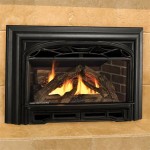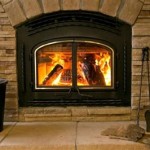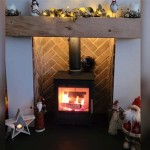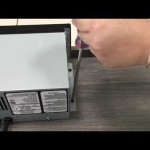Mantles for Gas Fireplaces: Elevating Aesthetics and Safety
Gas fireplaces offer a convenient and efficient heating solution, providing the ambiance of a traditional fireplace without the need for wood. However, the visual appeal of a gas fireplace can be significantly enhanced with the addition of a mantel. A mantel not only serves as a decorative element, but it can also provide a practical shelf space and, more importantly, act as a heat shield, protecting the surrounding wall and any combustible materials from the heat generated by the fireplace.
Choosing the right mantel for a gas fireplace requires careful consideration of several factors, including material, size, style, and adherence to safety regulations. Understanding these aspects will ensure that the selected mantel complements the fireplace and enhances the overall aesthetic of the room while maintaining a safe and functional environment.
Material Selection for Optimal Performance and Design
The material of a fireplace mantel significantly influences its heat resistance, aesthetic appeal, and overall durability. Common materials include wood, stone (including marble and granite), and manufactured materials like concrete and composite wood. Each material possesses unique characteristics that must be evaluated in relation to the specific gas fireplace and the surrounding environment.
Wood mantels offer a classic and versatile look, blending well with various interior design styles. However, because wood is combustible, it's crucial to ensure adequate clearance between the fireplace opening and the mantel. Building codes often specify minimum clearance requirements, typically measured from the top of the fireplace opening to the underside of the mantel. This distance helps to prevent the wood from overheating and potentially catching fire. Different types of wood also offer varying degrees of heat resistance. Hardwoods, such as oak and maple, tend to be more durable and less prone to warping than softwoods like pine.
Stone mantels, on the other hand, provide excellent heat resistance and can add a touch of elegance and sophistication to any room. Marble and granite are popular choices for their natural beauty and durability. Stone is generally a non-combustible material, allowing for closer proximity to the fireplace opening. However, it is still essential to consult local building codes and manufacturer specifications to ensure compliance and safe installation. The weight of stone mantels also necessitates careful consideration of the structural support required for installation.
Manufactured materials, such as concrete and composite wood, offer a balance of affordability, durability, and design flexibility. Concrete mantels can be cast into various shapes and finishes, providing a modern and industrial aesthetic. Composite wood mantels are often made from engineered wood products, such as MDF (medium-density fiberboard) or particleboard, and are typically covered with a veneer or laminate to mimic the look of real wood. These materials are generally more affordable than natural wood or stone but may not offer the same level of heat resistance. It is critical to verify the fire-resistance rating of the manufactured material and ensure it meets the applicable safety standards for use with a gas fireplace.
Sizing and Clearance Considerations for Safety and Aesthetics
Proper sizing and clearance are paramount for both the safety and visual harmony of a gas fireplace mantel installation. The size of the mantel should be proportional to the dimensions of the fireplace and the surrounding wall. A mantel that is too small may look insignificant, while a mantel that is too large can overwhelm the fireplace and detract from its overall appeal.
The width of the mantel should typically extend beyond the width of the fireplace opening, creating a balanced and visually pleasing effect. The depth of the mantel, or how far it projects from the wall, can also affect its appearance and functionality. A deeper mantel provides more shelf space but may also reduce the perceived space in the room. Careful consideration should be given to the overall dimensions of the room and the desired aesthetic when determining the appropriate depth of the mantel.
Clearance requirements are specified by building codes and fireplace manufacturers to ensure that combustible materials, such as the mantel, are kept at a safe distance from the heat source. These requirements typically involve minimum distances from the top and sides of the fireplace opening. The exact distances will vary depending on the type of fireplace, the material of the mantel, and local building regulations. It is imperative to consult both the fireplace manufacturer's instructions and local building codes before installing a mantel to ensure compliance and prevent the risk of fire.
In some cases, additional heat shielding may be required to reduce the temperature of the mantel. Heat shields are typically made from non-combustible materials, such as metal or ceramic, and are installed between the fireplace opening and the mantel. These shields help to deflect heat and protect the mantel from overheating. The need for a heat shield should be determined based on the fireplace manufacturer's recommendations and the specific clearance requirements.
Style and Design Harmony: Integrating the Mantel into the Room's Decor
The style of the mantel should complement the overall design aesthetic of the room. A wide range of mantel styles are available, from traditional and ornate designs to modern and minimalist styles. The choice of style should reflect the homeowner's personal preferences and the existing décor of the room.
Traditional mantels often feature intricate carvings, moldings, and decorative details. These mantels are typically made from wood or stone and can add a touch of elegance and formality to a room. They are often paired with traditional fireplace surrounds and accessories. A traditional mantel can be further enhanced with features like corbels, raised panels, and detailed trim work.
Modern mantels, on the other hand, tend to be more streamlined and minimalist in design. They often feature clean lines, simple shapes, and a lack of ornamentation. Modern mantels can be made from a variety of materials, including wood, concrete, and metal. They are often paired with contemporary fireplace surrounds and accessories. A focus on simplicity and functionality defines the modern mantel aesthetic.
Transitional mantels bridge the gap between traditional and modern styles, combining elements of both. They may feature clean lines and simple shapes with subtle decorative details. Transitional mantels can be made from a variety of materials and are often paired with a mix of traditional and contemporary furnishings. They offer a versatile option for homeowners who appreciate both classic and contemporary design elements.
In addition to the overall style, the finish and color of the mantel should also be carefully considered. The finish should complement the material of the mantel and the surrounding décor. Wood mantels can be stained or painted to match the existing woodwork in the room. Stone mantels can be polished or honed to enhance their natural beauty. The color of the mantel should also coordinate with the color scheme of the room. A contrasting color can create a focal point, while a complementary color can create a more cohesive look.
Finally, consider the use of accessories to further enhance the mantel's aesthetic appeal. Decorative items such as candles, vases, picture frames, and artwork can be placed on the mantel to add personality and visual interest. However, it is important to avoid placing combustible materials too close to the fireplace opening. Ensure that any items placed on the mantel are heat-resistant or positioned at a safe distance from the heat source.
Careful planning and attention to detail will ensure that the selected mantel not only enhances the visual appeal of the gas fireplace but also provides a safe and functional addition to the home. By considering the material, size, style, and safety regulations, homeowners can create a fireplace that is both beautiful and practical.

Types Of Fireplaces And Mantels The Home Depot
Fireplace Mantles Custom Made Barnwood By Century Home Renos Chr Contact Us Today 905 259 7307 Handcrafted Furnishings Timber Framing

Gas Fireplace Design Ideas S Remodel And Decor Contemporary Home

Custom Mantels Made In America Fireplace Xtrordinair

Mantels Horizon New Zealand

Fireplace Mantels For Buy Custom Chimney Usa Omega

Fireplace Mantels Mendota Hearth

Mantel And Hearth Considerations For Your Fireplace We Love Fire

Fireplace Mantels Mantel Shelves Custom Surrounds And More Direct

Stone Mantels Hearth Home
Related Posts








